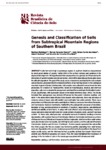Please use this identifier to cite or link to this item:
http://www.alice.cnptia.embrapa.br/alice/handle/doc/1055972| Title: | Genesis and classification of soils from subtropical mountain regions of Southern Brazil. |
| Authors: | DORTZBACK, D.  PEREIRA, M. G.   ANJOS, L. H. C. dos   FONTANA, A.   SILVA NETO, E. de C.   |
| Affiliation: | DENILSON DORTZBACH, EMATER-SC; MARCOS GERVASIO PEREIRA, UFRRJ; LÚCIA HELENA CUNHA DOS ANJOS, UFRRJ; ADEMIR FONTANA, CNPS; EDUARDO DE CARVALHO SILVA NETO, UFRRJ. |
| Date Issued: | 2016 |
| Citation: | Revista Brasileira de Ciência do Solo, Viçosa, MG, v. 40, 2016. |
| Description: | Soils formed in high mountainous regions in southern Brazil are characterized by great accumulation of organic matter (OM) in the surface horizons and variation in the degree of development. We hypothesized that soil properties and genesis are influenced by the interaction of parent materials and climate factors, which differ depending on the location along the altitudinal gradient. The goal of this study was to characterize and classify the soil, evaluate soil distribution, and determine the interactive effects of soil-forming factors in the subtropical mountain regions in Santa Catarina state. Soil samples were collected in areas known for wine production, for a total of 38 modal profiles. Based on morphological, physical, and chemical properties, soils were evaluated for pedogenesis and classified according to the Brazilian System of Soil Classification, with equivalent classes in the World Reference Basis (WRB). The results indicated that pedogenesis was strongly influenced by the parent material, weather, and relief. In the areas where basic effusive rocks (basalt) were observed, there was formation of extensive areas of clayey soils with reddish color and higher iron oxide contents. There was a predominance of Nitossolos Vermelhos and Háplicos (Nitisols), Latossolos Vermelhos (Ferralsols), and Cambissolos Háplicos (Cambisols), highlighting the pedogenetic processes of eluviation, illuviation of clay, and latosolization in conditions of year-long, large-volume, well-distributed rainfall and stability of land forms. In areas with acid effusive rocks (rhyodacites), medial or clayey soils were observed with lower iron oxide content, invariably acidic, and with low base content. For these soils, relief promoted substantial removal of material, resulting in intense rejuvenation, with a predominance of Cambissolos Háplicos (Cambisols) and lesser occurrence of Nitossolos Brunos (Nitisols) and Neossolos Litólicos (Leptosols). Soils formed from sedimentary rocks also tended to be more acidic, but with higher sand content, and the soils identified were Cambissolos Háplicos and Húmicos (Cambisols). Cluster analysis separated the soil profiles into three groups: the first and largest was formed by profiles originating from sedimentary rocks and rhyodacites; the second, smaller group was formed by four profiles in the Água Doce region (acidic rocks); and the third was formed by profiles derived from basalt. Discriminant analysis was effective in grouping soil classes. Thus, the study highlighted the importance of geology in the formation of soils in this landscape associated with climate and relief. |
| Thesagro: | Geologia |
| Keywords: | Formação do solo Classificação taxonômica |
| DOI: | https://doi.org/10.1590/18069657rbcs20150503 |
| Type of Material: | Artigo de periódico |
| Access: | openAccess |
| Appears in Collections: | Artigo em periódico indexado (CNPS)  |
Files in This Item:
| File | Description | Size | Format | |
|---|---|---|---|---|
| 2016068.pdf | 541,83 kB | Adobe PDF |  View/Open |









